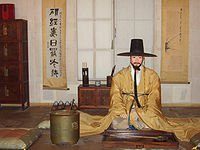- Dopo (clothing)
-
Dopo (clothing)
A mustard-colored dopoKorean name Hangul 도포 Hanja 道袍 Revised Romanization dopo McCune–Reischauer top'o The dopo is a variety of po, or overcoat in hanbok, Korean traditional garment which was mostly worn by male Confucian scholars called seonbi after the mid Joseon period. Seonbi wore it as their daily garment as well as government officers did when they out for their private business. There are several speculations over the origin of the dopo. According to historical documents such as Seongho saseol (성호사설), Ojuyeon munjang jeonsango (오주연문장전산고), the garment was influenced by Buddhism. The authors claimed that dopo was originally monk's robe called, gwontu (권투 圈套) which was identical to jangsam, another monk's garment.[1][2][3]
See also
References
- ^ "도포 (道袍)" (in Korean). Empas / EncyKorea. http://100.empas.com/dicsearch/pentry.html?s=K&i=240982&v=44. Retrieved 2008-09-30.
- ^ "도포 (道袍)" (in Korean). Doosan Encyclopedia. http://map.encyber.com/search_w/ctdetail.php?&masterno=48519&contentno=48519. Retrieved 2008-09-30.
- ^ "도포 (道袍)" (in Korean). Empas / Britannica. http://100.empas.com/dicsearch/pentry.html?s=B&i=127149&v=44. Retrieved 2008-09-30.
- Lee Ho-jeong (2007-05-07). "Clothing with stories of fertility and faith". JoonAng Daily. http://joongangdaily.joins.com/article/view.asp?aid=2875224.
External links
Categories:- Korean clothing
- Korea stubs
- Fashion stubs
Wikimedia Foundation. 2010.

